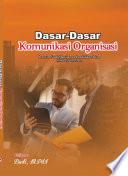
Dasar-Dasar Komunikasi Organisasi
Buku ini merupakan bentuk hasil dari kerjasama para penulis yaitu mahasiswa dan mahasiswi dari prodi manajemen pendidikan Islam semester V dan mahasiswa pengambilan semester III dalam rangka memberikan output dari hasil pembelajaran mata kuliah komunikasi organisasi. Buku ini berisi mengenai materi pembelajaran yang yang dibahas dalam mata kuliah komunikasi organisasi berdasarkan silabus yang telah ditentukan.
- ISBN 13 : 6236853568
- ISBN 10 : 9786236853566
- Judul : Dasar-Dasar Komunikasi Organisasi
- Pengarang : Budi, M.Pd.I, M.Pd.I, M.Pd.I, M.Pd.I,
- Kategori : Education
- Penerbit : Cv. Pusdikra Mitra Jaya
- Bahasa : id
- Halaman : 153
- Google Book : https://play.google.com/store/books/details?id=ZLZQEAAAQBAJ&source=gbs_api
-
Ketersediaan :
Editor : Budi, M.Pd.I membentuk kesamaan identitas dan komitmen bersama sehingga arah pengembangan lembaga pendidikan Islam dapat dipahami semua pihak yang terkait (set mission). Sebenarnya budaya organisasi di lembaga pendidikan Islam ...







